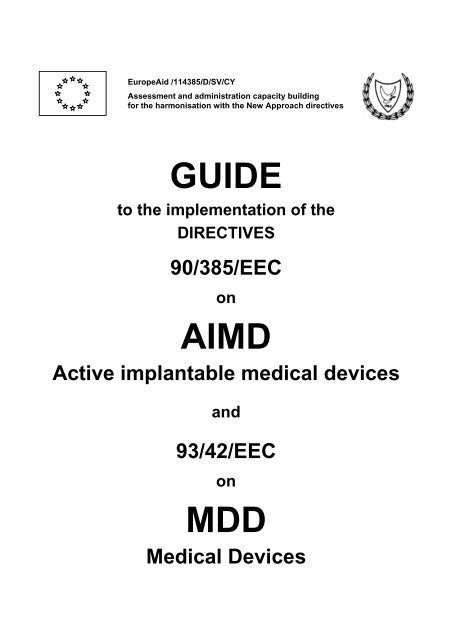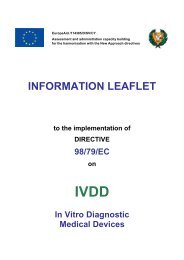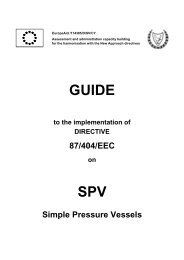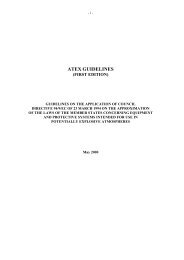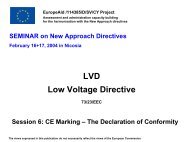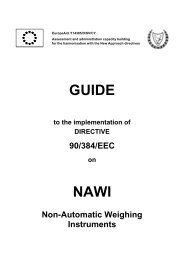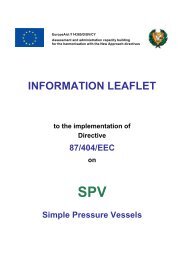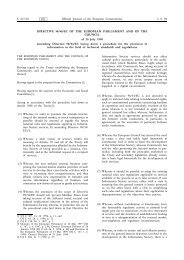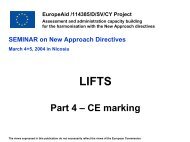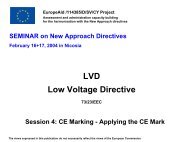GUIDE AIMD MDD - Cyprus Organization for the Promotion of Quality
GUIDE AIMD MDD - Cyprus Organization for the Promotion of Quality
GUIDE AIMD MDD - Cyprus Organization for the Promotion of Quality
You also want an ePaper? Increase the reach of your titles
YUMPU automatically turns print PDFs into web optimized ePapers that Google loves.
EuropeAid /114385/D/SV/CYAssessment and administration capacity building<strong>for</strong> <strong>the</strong> harmonisation with <strong>the</strong> New Approach directives<strong>GUIDE</strong>to <strong>the</strong> implementation <strong>of</strong> <strong>the</strong>DIRECTIVES90/385/EECon<strong>AIMD</strong>Active implantable medical devicesand93/42/EECon<strong>MDD</strong>Medical Devices
Guide on <strong>MDD</strong> + <strong>AIMD</strong> DirectiveEuropeAid /114385/D/SV/CYThis Guide was printed with funds <strong>of</strong> <strong>the</strong> EuropeAid /114385/D/SV/CY project:“Assessment and administration capacity building <strong>for</strong> <strong>the</strong> harmonisation with <strong>the</strong> New Approach directives”The views expressed in this publication do not necessarily reflect <strong>the</strong> views <strong>of</strong> <strong>the</strong> European Commissionor <strong>the</strong> <strong>Cyprus</strong> Ministry <strong>of</strong> Commerce, Industry and Tourism.© Republic <strong>of</strong> <strong>Cyprus</strong>, Nicosia, May 2004
Guide on <strong>MDD</strong> + <strong>AIMD</strong> DirectiveEuropeAid /114385/D/SV/CYINTRODUCTIONThe in<strong>for</strong>mation in this guide is intended as general guidance and should not be regarded as anauthoritative statement <strong>of</strong> <strong>the</strong> law. Manufacturers and o<strong>the</strong>rs should not rely on this in<strong>for</strong>mation but shouldconsult <strong>the</strong> legislation referred to, making <strong>the</strong>ir own decisions on matters affecting <strong>the</strong>m in conjunctionwith <strong>the</strong>ir lawyers and o<strong>the</strong>r pr<strong>of</strong>essional advisers.WHAT IS A MEDICAL DEVICE?A series <strong>of</strong> three Directives regulating <strong>the</strong> safety and marketing <strong>of</strong> medical devices throughout <strong>the</strong>European Union started to come into effect from 1 January 1993.For <strong>the</strong> purposes <strong>of</strong> <strong>the</strong> Directives, a medical device is defined as:"any instrument, apparatus, appliance material or o<strong>the</strong>r article, whe<strong>the</strong>r uses alone or incombination, including <strong>the</strong> s<strong>of</strong>tware necessary <strong>for</strong> its proper application intended by <strong>the</strong>manufacturer to be used on human beings <strong>for</strong> <strong>the</strong> purpose <strong>of</strong>:• diagnosis, prevention, monitoring, treatment or alleviation <strong>of</strong> disease,• diagnosis, monitoring, treatment, or alleviation <strong>of</strong> or compensation <strong>for</strong> an injury orhandicap,• investigation, replacement or modification <strong>of</strong> <strong>the</strong> anatomy or <strong>of</strong> a physiological process,• control <strong>of</strong> conceptionand which does not achieve its principal intended action in or on <strong>the</strong> human body bypharmacological, immunological or metabolic means, but which may be assisted in its function bysuch means".WHY DO WE NEED THE DIRECTIVES?Be<strong>for</strong>e <strong>the</strong> introduction <strong>of</strong> <strong>the</strong> medical devices Directives, each Member State in <strong>the</strong> EuropeanUnion would control <strong>the</strong> safety and marketing <strong>of</strong> medical devices on its territory in different ways.The Directives benefit manufacturers by harmonising controls within a single system and avoid<strong>the</strong> need <strong>for</strong> manufacturers having to comply with 15 (or 25) different sets <strong>of</strong> rules. Purchasersand users can also be reassured that devices manufactured anywhere in <strong>the</strong> Union should meetcommon standards <strong>of</strong> per<strong>for</strong>mance and safety.The Directives benefit patients and users, by setting out essential requirements that productsmust meet. These make it clear that devices must not compromise <strong>the</strong> health or safety <strong>of</strong> <strong>the</strong>patient, user or any o<strong>the</strong>r person, and that any risks associated with <strong>the</strong> device are compatiblewith patient health and protection. Any side effects must be acceptable when weighed against <strong>the</strong>intended per<strong>for</strong>mance <strong>of</strong> a device. Devices meeting <strong>the</strong>se requirements generally carry <strong>the</strong> "CE"marking to show that <strong>the</strong>y comply.THE DIRECTIVESTHE ACTIVE IMPLANTABLE MEDICAL DEVICES DIRECTIVEThis first Directive covers all powered implants or partial implants that are left in <strong>the</strong> human body. Heartpacemakers are <strong>the</strong> most common example <strong>of</strong> powered implants.
Guide on <strong>MDD</strong> + <strong>AIMD</strong> DirectiveEuropeAid /114385/D/SV/CYTHE MEDICAL DEVICES DIRECTIVEThe second Directive covers most o<strong>the</strong>r medical devices, ranging from, <strong>for</strong> example, first aid bandages,tongue depressors, hip pros<strong>the</strong>ses, X-Ray equipment, ECG and heart valves.THE IN VITRO DIAGNOSTIC MEDICAL DEVICES DIRECTIVEThe third Directive covers any medical device which is a reagent, reagent product, calibrator, controlmaterial, kit, instrument, apparatus, equipment or system intended <strong>for</strong> use in-vitro <strong>for</strong> <strong>the</strong> examination <strong>of</strong>specimens, including blood and tissue donations, derived from <strong>the</strong> human body. Examples <strong>of</strong> in-vitrodiagnostic devices are blood grouping reagents, pregnancy test kits and Hepatitis B test kits.KEY POINTS IN THE DIRECTIVESCE MARKINGThe CE marking that appears on a medical device or on its packaging means that <strong>the</strong> device satisfies <strong>the</strong>relevant essential requirements and is fit <strong>for</strong> its intended purpose as specified by <strong>the</strong> manufacturer.Eventually all devices, (except custom-made devices, those intended <strong>for</strong> clinical investigations anddevices <strong>for</strong> per<strong>for</strong>mance evaluation) whe<strong>the</strong>r used in private or public hospitals and nursing homes or soldin retail outlets, will have to carry <strong>the</strong> CE marking.CLASSIFICATIONThe Medical Devices Directive and <strong>the</strong> In Vitro Diagnostic Medical Devices Directive include aclassification system whereby <strong>the</strong> level <strong>of</strong> regulatory control applied to devices is proportionate to <strong>the</strong>degree <strong>of</strong> risk associated with <strong>the</strong> device. The strictest controls <strong>the</strong>re<strong>for</strong>e apply only to high-risk products.THE COMPETENT AUTHORITYThe Competent Authority is <strong>the</strong> body responsible <strong>for</strong> implementing <strong>the</strong> requirements <strong>of</strong> <strong>the</strong> Directives ineach Member State. In <strong>the</strong> UK, <strong>the</strong> Competent Authority is <strong>the</strong> Secretary <strong>of</strong> State <strong>for</strong> Health acting through<strong>the</strong> MHRA. The Competent Authority's main role is to ensure that manufacturers comply with <strong>the</strong>Regulations, to evaluate adverse incident reports received from manufacturers, and carry out a pre-clinicalassessment <strong>of</strong> devices intended <strong>for</strong> clinical investigation.NOTIFIED BODIESThe Competent Authority is also responsible <strong>for</strong> designating <strong>the</strong> independent certification organisations(Notified Bodies) that check that manufacturers <strong>of</strong> medium and high risk medical devices have followed<strong>the</strong> requirements. Once <strong>the</strong>y are satisfied, manufacturers may apply <strong>the</strong> CE marking to <strong>the</strong>ir products andplace <strong>the</strong>m on <strong>the</strong> market.CLINICAL INVESTIGATIONSThe Directives require all devices intended <strong>for</strong> clinical investigation in <strong>the</strong> EU to be <strong>for</strong>mally assessed on<strong>the</strong> risks such investigations might pose to <strong>the</strong> health and safety <strong>of</strong> patients. For most medical devices(except in-vitro diagnostic devices) manufacturers have to in<strong>for</strong>m <strong>the</strong> relevant Competent Authority if <strong>the</strong>yintend to start a clinical investigation at least 60 days be<strong>for</strong>e it is due to begin. The investigation may startafter <strong>the</strong> 60-day period unless <strong>the</strong> Competent Authority notifies <strong>the</strong> manufacturer <strong>of</strong> a decision to <strong>the</strong>contrary on grounds <strong>of</strong> public health.
Guide on <strong>MDD</strong> + <strong>AIMD</strong> DirectiveEuropeAid /114385/D/SV/CYADVERSE INCIDENT REPORTING (VIGILANCE)Manufacturers are required to report serious incidents to <strong>the</strong> Competent Authority. In<strong>for</strong>mation about<strong>the</strong>se is collected and evaluated centrally and, where necessary, made available to o<strong>the</strong>r Member States.The overall aim <strong>of</strong> <strong>the</strong> system is to improve <strong>the</strong> safety <strong>of</strong> patients, users and o<strong>the</strong>rs by trying to preventincidents similar to those reported occurring elsewhere in <strong>the</strong> Union.FIELD OF APPLICATION - DEFINITIONSDIRECTIVE 93/42/EEC ON MEDICAL DEVICESDEFINITION OF "MEDICAL DEVICES"a) devices - accessoryThe definition <strong>of</strong> <strong>the</strong> term "medical device" toge<strong>the</strong>r with <strong>the</strong> definition <strong>of</strong> "accessory" is determinant<strong>for</strong> <strong>the</strong> delimitation <strong>of</strong> <strong>the</strong> field <strong>of</strong> application <strong>of</strong> Directive 93/42/EEC. A slight difference existsbetween <strong>the</strong> definition in article 1(2) (a) <strong>of</strong> Directive 93/42/EEC and in article 1(2) <strong>of</strong> Directive90/385/EEC.Following <strong>the</strong> latter directive, accessories are by definition medical devices, whilst following Directive93/42/EEC, a distinction is made between "devices" and "accessories". There<strong>for</strong>e within <strong>the</strong> meaning<strong>of</strong> Directive 93/42/EEC, accessories are products in <strong>the</strong>ir own right and, although being treated asdevices (article 1(1)) do not follow, as a general rule, <strong>the</strong> classification <strong>of</strong> related devices inconjunction with which <strong>the</strong>y are used.Accessories are <strong>the</strong>re<strong>for</strong>e following Directive 93/42/EEC to be classified in <strong>the</strong>ir own right.b) medical purposeMedical devices are defined as articles which are intended to be used <strong>for</strong> a medical purpose. Themedical purpose is assigned to a product by <strong>the</strong> manufacturer. The manufacturer determines through<strong>the</strong> label, <strong>the</strong> instruction <strong>for</strong> use and <strong>the</strong> promotional material related to a given device its specificmedical purpose. As <strong>the</strong> directive aims essentially at <strong>the</strong> protection <strong>of</strong> patients and users, <strong>the</strong> medicalpurpose relates in general to finished products regardless <strong>of</strong> whe<strong>the</strong>r <strong>the</strong>y are intended to be usedalone or in combination. This means that <strong>the</strong> protection ensured by <strong>the</strong> directive becomes valid <strong>for</strong>products having a stage <strong>of</strong> manufacture, where <strong>the</strong>y are supplied to <strong>the</strong> final user.Following this concept, raw materials, components or intermediate products are as such normally notmedical devices. Such raw materials may need to present properties or characteristics which aredeterminant <strong>for</strong> <strong>the</strong> safety and quality <strong>of</strong> finished devices. It is <strong>the</strong>re<strong>for</strong>e <strong>the</strong> responsibility <strong>of</strong> <strong>the</strong>manufacturer <strong>of</strong> finished devices to select and control by adequate means his raw materials orintermediate products (see Annex I, section 7.1; Annex II, section 3.2; Annex V, section 3.2 <strong>of</strong>Directive 93/42/EEC)Spare parts supplied <strong>for</strong> replacement <strong>of</strong> existing components <strong>of</strong> a device, <strong>the</strong> con<strong>for</strong>mity <strong>of</strong> which hasalready been established, are not medical devices. If spare parts, however, change significantly <strong>the</strong>characteristics or per<strong>for</strong>mances <strong>of</strong> a device with regard to its already established con<strong>for</strong>mity, suchspare parts are to be considered as devices in <strong>the</strong>ir own right.c) customizingThe concept <strong>of</strong> "finished device" does not imply that a device when reaching <strong>the</strong> final user is alreadyin a state ready <strong>for</strong> use. Prior to use fur<strong>the</strong>r preparatory processing, preparation, configuration,installation, assembling, adaptation or fitting to <strong>the</strong> needs <strong>of</strong> <strong>the</strong> user or patient may be required.Examples :
Guide on <strong>MDD</strong> + <strong>AIMD</strong> DirectiveEuropeAid /114385/D/SV/CY• sterilisation <strong>of</strong> medical devices supplied non-sterile• assembling <strong>of</strong> systems• configuration <strong>of</strong> electronic equipment• preparation <strong>of</strong> a dental filling• fitting <strong>of</strong> contact lenses• adaptation <strong>of</strong> pros<strong>the</strong>sis to <strong>the</strong> needs <strong>of</strong> <strong>the</strong> patient.The a<strong>for</strong>ementioned activities are normally not manufacturers activities if <strong>the</strong>y are carried out by <strong>the</strong>final user as part <strong>of</strong> <strong>the</strong> use or preparation <strong>for</strong> use. In this context a distinction needs to be madebetween a typical pr<strong>of</strong>essional activity per<strong>for</strong>med by a healthcare pr<strong>of</strong>essional and processing andassembling activities done by a specialist <strong>for</strong> such processing. In <strong>the</strong> latter case relevant activitiesmay become proper manufacturing or assembling activities relevant within <strong>the</strong> meaning <strong>of</strong> articles 11and 12.A particular consideration in this context needs to be given <strong>for</strong> <strong>the</strong> manufacture <strong>of</strong> custom-madedevices. Custom-made devices (such as dental appliances, pros<strong>the</strong>sis, hearing-aid inserts) are inmost cases one-<strong>of</strong>f devices and <strong>the</strong> Directive subjects <strong>the</strong>ir manufacture to <strong>the</strong> procedure <strong>of</strong> article11(6) in conjunction with Annex VIII. In <strong>the</strong>se cases intermediate products specifically intended <strong>for</strong>this kind <strong>of</strong> custom-made devices may be considered also as medical devices.This applies essentially to dental alloys, dental ceramics, modular components <strong>for</strong> pros<strong>the</strong>sis, if <strong>the</strong>intended purpose <strong>of</strong> such products is specifically related to medical devices.d) medical - toiletry purposeThe definition <strong>of</strong> "medical device" should be understood to include products intended to be usedprincipally <strong>for</strong> a medical use. There<strong>for</strong>e products intended to have a toiletry or cosmetic purpose arenot medical devices even though <strong>the</strong>y may be used <strong>for</strong> prevention <strong>of</strong> a disease. Examples <strong>for</strong>products <strong>for</strong> which a medical purpose can normally not be established:• tooth brushes, dental sticks, dental floss;• baby diapers, hygiene tampons;• contact lenses without corrective function intended to provide ano<strong>the</strong>r colour to <strong>the</strong> eyes,bleaching products <strong>for</strong> teeth• instruments <strong>for</strong> tattooing.Examples <strong>for</strong> products, where depending on <strong>the</strong> circumstances, a medical purpose can beestablished:incontinence products.e) aids <strong>for</strong> handicapped personsIn <strong>the</strong> case <strong>of</strong> equipment intended <strong>for</strong> alleviation <strong>of</strong> or compensation <strong>for</strong> a handicap, <strong>the</strong>re must be adirect link between <strong>the</strong> corrective function and <strong>the</strong> person concerned. There<strong>for</strong>e <strong>the</strong> followingequipment is not medical devices:f) s<strong>of</strong>tware• acoustic signals at traffic lights,• special water taps, toilet equipment <strong>for</strong> handicappedThe following distinction can be made: s<strong>of</strong>tware influencing <strong>the</strong> proper functioning <strong>of</strong> a device ands<strong>of</strong>tware used in combination with non-medical equipment.
Guide on <strong>MDD</strong> + <strong>AIMD</strong> DirectiveEuropeAid /114385/D/SV/CYS<strong>of</strong>tware related to <strong>the</strong> functioning <strong>of</strong> a medical device may be part <strong>of</strong> a device or a device in its ownright if it is placed on <strong>the</strong> market separately from <strong>the</strong> related device.In <strong>the</strong> case <strong>of</strong> s<strong>of</strong>tware intended <strong>for</strong> use with multipurpose in<strong>for</strong>matics equipment a distinction has tobe made between s<strong>of</strong>tware providing <strong>for</strong> a proper diagnostic or <strong>the</strong>rapeutic tool and s<strong>of</strong>tware <strong>for</strong>handling general patient-related data. Only in <strong>the</strong> first case may a medical purpose be determined.Examples <strong>for</strong> medical devices:• calculation <strong>of</strong> anatomical sites <strong>of</strong> <strong>the</strong> body,• image enhancing s<strong>of</strong>tware intended <strong>for</strong> diagnostic purpose.• s<strong>of</strong>tware <strong>for</strong> programming a medical deviceThere is no medical purpose in <strong>the</strong> case <strong>of</strong> s<strong>of</strong>tware used <strong>for</strong> administration <strong>of</strong> general patient datag) multipurpose productsProducts with a multiple purpose which may be used occasionally in a medical environment arenormally not medical devices, unless a specific medical intended purpose is assigned to <strong>the</strong>m.Examples:• multipurpose PC, printer, scanner, ...• magneto scope, screen.DEFINITION OF "ACCESSORY"The question whe<strong>the</strong>r a product is a "device" or an "accessory" has no practical consequence. Followingarticle 1(1) <strong>of</strong> Directive 93/42/EEC, "accessories shall be treated as medical devices in <strong>the</strong>ir own right".There<strong>for</strong>e <strong>the</strong> main question is whe<strong>the</strong>r a product with a ra<strong>the</strong>r remote link to a medical use can still beconsidered as "accessory" (article 1(2)b) and as a matter <strong>of</strong> consequence is covered by <strong>the</strong> directive.The definition <strong>of</strong> "accessory" requires that <strong>the</strong> accessory is specifically intended by <strong>the</strong> manufacturer <strong>of</strong><strong>the</strong> accessory to be used toge<strong>the</strong>r with a device. The intended use <strong>of</strong> <strong>the</strong> accessory must be such as toenable a device to be used in accordance with its intended use. There<strong>for</strong>e a product can only become anaccessory to a medical device if <strong>the</strong> manufacturer <strong>of</strong> such a product establishes an intended use inconjunction with one or several medical devices.Examples <strong>for</strong> accessories depending on defined circumstances <strong>of</strong> device related use:• sterilizers <strong>for</strong> use in a medical environment,• pouches <strong>for</strong> packaging re-sterilised medical devices,• specific battery chargers <strong>for</strong> battery driven electro medical devices,• contact lens care products, disinfectants specifically intended <strong>for</strong> invasive medical devices• special water treatment device <strong>for</strong> use in conjunction with dialyzing machines,• gas cylinders/pressure release devices <strong>for</strong> use in conjunction with anaes<strong>the</strong>sia machines.DEFINITION OF "MANUFACTURER"USERS IN-HOUSE MANUFACTURINGThe Directive defines a manufacturer as <strong>the</strong> natural or legal person responsible <strong>for</strong> defined manufacturingactivities related to a device with a view to its being placed on <strong>the</strong> market under <strong>the</strong> manufacturers ownname.
Guide on <strong>MDD</strong> + <strong>AIMD</strong> DirectiveEuropeAid /114385/D/SV/CYThe reason <strong>for</strong> this link with <strong>the</strong> placing on <strong>the</strong> market is that <strong>the</strong> directives aim to subject to its protectionrequirements <strong>the</strong> transaction <strong>of</strong> a device from <strong>the</strong> sphere <strong>of</strong> a manufacturer towards <strong>the</strong> public. Thedirective does not provide any specific provisions <strong>for</strong> <strong>the</strong> case where a device is manufactured by <strong>the</strong> user(<strong>for</strong> example, a hospital) without being transferred to ano<strong>the</strong>r person. The decision to which extent suchin-house manufacturing activities by hospitals are subjected to legal requirements, belongs <strong>the</strong>re<strong>for</strong>e to<strong>the</strong> national legislator. This relates however exclusively to such in-house manufacturing activities where adevice remains within <strong>the</strong> users, but not to cases where, <strong>for</strong> example, a hospital produces orthopedicdevices <strong>for</strong> use with patients.DIRECTIVE 90/385/EEC ON ACTIVE IMPLANTABLE MEDICAL DEVICESACTIVE IMPLANTABLE MEDICAL DEVICEA product falls within <strong>the</strong> field <strong>of</strong> application <strong>of</strong> <strong>the</strong> Directive if it complies with <strong>the</strong> definition given in thisDirective. That means, it must be a "medical device" as defined which is, at <strong>the</strong> same time, both "active"and "implantable".a) DeviceThe "device" definition within <strong>the</strong> meaning <strong>of</strong> Directive 90/385/EEC relates to a product intended by<strong>the</strong> manufacturer <strong>for</strong> a medical purpose "whe<strong>the</strong>r used alone or in combination, toge<strong>the</strong>r with anyaccessories or s<strong>of</strong>tware <strong>for</strong> its proper functioning". The medical purpose may be achieved ei<strong>the</strong>r by a"stand alone device" or as a result <strong>of</strong> several devices acting each in combination with <strong>the</strong> o<strong>the</strong>r aspart <strong>of</strong> a system. Where <strong>the</strong> medical purpose is achieved by a system, each element <strong>of</strong> <strong>the</strong> systemmay be regarded as a medical device.The device definition may consequently apply to <strong>the</strong> system as such or to interchangeable partsintended to <strong>for</strong>m a system toge<strong>the</strong>r with o<strong>the</strong>r devices, <strong>the</strong>re<strong>for</strong>e <strong>for</strong> <strong>the</strong> purposes <strong>of</strong> <strong>the</strong> Directive onActive Implantable Medical Devices each part belonging to such system is covered by <strong>the</strong> Directiveregardless <strong>of</strong> whe<strong>the</strong>r such part on its own is "active", "active implantable" or not.Examples <strong>of</strong> <strong>AIMD</strong>s :• implantable pulse generator <strong>for</strong> pacing including <strong>the</strong> electrode• implantable pulse generator without electrode• electrode• implantable drug administration device with or without ca<strong>the</strong>ter• ca<strong>the</strong>ter <strong>for</strong> implantable drug administration deviceb) Active deviceFor <strong>the</strong> purpose <strong>of</strong> <strong>the</strong> Directive 90/385/EEC a medical device is active if it "relies <strong>for</strong> its functioningon a source <strong>of</strong> electrical energy or any source <strong>of</strong> power o<strong>the</strong>r than that directly generated by <strong>the</strong>human body or gravity. This includes, <strong>for</strong> instance, devices activated by means <strong>of</strong> pressure unlessthis effect is achieved by energy resulting from <strong>the</strong> body <strong>of</strong> <strong>the</strong> patient. The definition implies that <strong>the</strong>function <strong>of</strong> <strong>the</strong> device involves using <strong>the</strong> source <strong>of</strong> power to per<strong>for</strong>m useful work. The meretransmission <strong>of</strong> heat, light, pressure or vibration does not mean that a device is active.Examples :• a hydrocephalus pressure relief allowing release <strong>of</strong> cerebro-spinal fluid when a spring isovercome is not "active". Even where <strong>the</strong> setting <strong>of</strong> <strong>the</strong> spring can be adjusted by electromagneticmeans, it remains non-active as <strong>the</strong> medical function <strong>of</strong> <strong>the</strong> device is to relievepressure, not to be adjusted,
Guide on <strong>MDD</strong> + <strong>AIMD</strong> DirectiveEuropeAid /114385/D/SV/CY• a drug delivery device in which <strong>the</strong> drug is driven from a reservoir by means <strong>of</strong> a storedenergy source (spring, fluid, gas, etc...) is "active"• an intravascular ca<strong>the</strong>ter containing a fibre-optic bundle connected to an external light sourcemay be used to measure pressure or o<strong>the</strong>r characteristics <strong>of</strong> blood if some quality <strong>of</strong> <strong>the</strong> lightcan be changed by <strong>the</strong> blood characteristic and detected. Although <strong>the</strong> system as a wholedepends on a power source to achieve its medical function (<strong>the</strong> measurement <strong>of</strong> a bloodcharacteristic) <strong>the</strong> invasive element is not "active" as it does no more than transmit light• a cochlear implant activated by an external power transmitter is regarded as "active" as <strong>the</strong>implanted component clearly depends on a power source <strong>for</strong> its function and its purpose is toconvert <strong>the</strong> power it receives into electrical signals which trigger appropriate sensorychannels in <strong>the</strong> brain, i.e. it per<strong>for</strong>ms useful work.c) Implantable deviceAn active medical device is defined as "implantable" if it is "totally or partly introduced, surgically ormedically, into <strong>the</strong> human body or by medical intervention into a natural orifice, and which is intendedto remain after <strong>the</strong> procedure".The Directive has been conceived <strong>for</strong> active devices <strong>for</strong> which a potential high risk may be inherentdue to <strong>the</strong> fact that <strong>the</strong>y are totally or partly implanted into <strong>the</strong> body. Such devices may presenthazards in particular with regard to impossibility <strong>of</strong> maintenance, calibration or control and problemsrelating to <strong>the</strong> ageing <strong>of</strong> materials, as mentioned in several essential requirements <strong>of</strong> Annex 1 to <strong>the</strong>Directive. The attribute "implantable" has <strong>the</strong>re<strong>for</strong>e to be interpreted bearing in mind those hazardstypical <strong>for</strong> implantable devices.For <strong>the</strong> a<strong>for</strong>ementioned reasons, an external drug infusion pump, although <strong>for</strong> long-term orpermanent use, which is connected to a ca<strong>the</strong>ter "partially introduced" into <strong>the</strong> body is not consideredas an active implantable device.One <strong>of</strong> <strong>the</strong> essential characteristics <strong>of</strong> an implantable device is its relatively long-term use. Distinctionis to be made between an intended use <strong>of</strong> a device which is permanent or longterm in <strong>the</strong> order <strong>of</strong>several months compared to a temporary use during a given medical intervention. An externalpacemaker, including its electrode, used <strong>for</strong> an interim process is thus not considered as "remainingafter <strong>the</strong> procedure". The same applies to <strong>the</strong> use <strong>of</strong> an intra-aortic balloon pump. For <strong>the</strong> purpose <strong>of</strong><strong>the</strong> Directive 90/385/EEC, <strong>the</strong> term "procedure" is to be interpreted as a process <strong>of</strong> diagnosis,monitoring or treatment which may last <strong>for</strong> some days, generally in hospital, and not necessarilyexclusively relating to an operation carried out in <strong>the</strong> <strong>the</strong>atre in <strong>the</strong> course <strong>of</strong> which <strong>the</strong> device isplaced in <strong>the</strong> body.DEFINITION OF ACCESSORY"Accessories" to an active implantable medical device are by definition "active implantable medicaldevices" and <strong>the</strong>re<strong>for</strong>e covered by <strong>the</strong> Directive 90/385/EEC. This does not presuppose that <strong>the</strong>attributes "active" and "implantable" must be necessarily met by a product called "accessory". It issufficient that a product in its intended purpose is ancillary to <strong>the</strong> purpose <strong>of</strong> an active implantablemedical device in such a way that it enables <strong>the</strong> device to be used in accordance with <strong>the</strong> intendeddevice purpose or that it enhances <strong>the</strong> purpose <strong>of</strong> a device as intended by <strong>the</strong> device manufacturer.Following this a programmer or an external transmitter intended <strong>for</strong> activating or controlling <strong>the</strong>implantable part <strong>of</strong> <strong>the</strong> device is covered by <strong>the</strong> definition <strong>of</strong> "active implantable medical device".
Guide on <strong>MDD</strong> + <strong>AIMD</strong> DirectiveEuropeAid /114385/D/SV/CYEXEMPLATIVE LIST OF ACTIVE IMPLANTABLE MEDICAL DEVICES.The subsequent list contains examples <strong>of</strong> types <strong>of</strong> devices which are normally covered by Directive90/385/EEC :1. implantable cardiac pacemakers2. implantable defibrillators3. leads, electrodes, adaptors <strong>for</strong> 1. and 2.4. implantable nerve stimulators5. bladder stimulators6. sphincter stimulators7. diaphragm stimulators8. cochlear implants9. implantable active drug administration device10. ca<strong>the</strong>ters, sensors <strong>for</strong> 9.11. implantable active monitoring devices12. programmers, s<strong>of</strong>tware, transmitters.INTERFACES WITH OTHER DIRECTIVESDIRECTIVE 65/65/EEC RELATING TO MEDICINAL PRODUCTSA product will normally only be subject to <strong>the</strong> requirements <strong>of</strong> ei<strong>the</strong>r one <strong>of</strong> <strong>the</strong> medical devices directivesor <strong>the</strong> directive on medicinal products. In order to decide which <strong>of</strong> <strong>the</strong>se Directives applies, <strong>the</strong> followingpoints should be considered:• <strong>the</strong> intended purpose <strong>of</strong> <strong>the</strong> product taking into account <strong>the</strong> way <strong>the</strong> product is presented;• <strong>the</strong> method by which <strong>the</strong> principal intended action is achieved.In <strong>the</strong> case <strong>of</strong> a medical device, <strong>the</strong> principal intended action is typically fulfilled by physical means(including mechanical action, physical barrier, replacement <strong>of</strong>, or support to, organs or body functions).The action <strong>of</strong> a medicinal product is typically achieved by pharmacological, immunological or metabolicmeans; a substance administered <strong>for</strong> diagnostic purposes is also usually considered to be a medicinalproduct.Medical devices may be assisted in <strong>the</strong>ir function by pharmacological, immunological or metabolic means.Where such means are primary with respect to <strong>the</strong> principal purpose <strong>of</strong> <strong>the</strong> product, it is regarded as amedicinal product.Devices that incorporate or are used to administer a drug are covered by <strong>the</strong> Medical Devices Directive,except <strong>for</strong> active implantable devices (e.g. implantable infusion pumps) used to administer a drug whichare covered by <strong>the</strong> Active Implantable Devices Directive.As indicated above, <strong>the</strong> intended principal function <strong>of</strong> <strong>the</strong> product and <strong>the</strong> method by which this action isachieved determines <strong>the</strong> legislation relevant to <strong>the</strong> products.There are three types <strong>of</strong> device which incorporate or are used to administer a product:
Guide on <strong>MDD</strong> + <strong>AIMD</strong> DirectiveEuropeAid /114385/D/SV/CY• Devices which are used to administer medicinal products (e.g. a syringe marketed empty) arecovered by <strong>the</strong> relevant Medical Devices Directive. Empty devices (e.g. medicine spoons,droppers etc) or devices which can be refilled with fur<strong>the</strong>r doses <strong>of</strong> medication contained within<strong>the</strong> same pack as <strong>the</strong> medicine are included within this category.• Devices <strong>for</strong> administering medicinal products where <strong>the</strong> device and <strong>the</strong> medicinal product <strong>for</strong>m asingle integral product designed to be used exclusively in <strong>the</strong> given combination and which are notre-usable (e.g. a syringe marketed pre-filled) or re-fillable are subject to Directive 65/65/EEC. Inaddition, <strong>the</strong> relevant essential requirements in Annex 1 <strong>of</strong> <strong>the</strong> Medical Devices Directive93/42/EEC apply with respect to safety and per<strong>for</strong>mance related features <strong>of</strong> <strong>the</strong> device (e.g. asyringe <strong>for</strong>ming part <strong>of</strong> such a product).• Devices incorporating, as an integral part <strong>of</strong> a substance, which, if used separately, may beconsidered to be a medicinal product and which is such that <strong>the</strong> substance is liable to act upon <strong>the</strong>body with action ancillary to that <strong>of</strong> <strong>the</strong> device (e.g. a heparin coated ca<strong>the</strong>ter) are subject to <strong>the</strong>Medical Devices Directive. In addition, <strong>the</strong> safety, quality and usefulness <strong>of</strong> <strong>the</strong> medicinalsubstance must be verified by analogy with <strong>the</strong> methods in Directive 75/318/EEC concerning <strong>the</strong>testing <strong>of</strong> proprietary medicinal products. Under <strong>the</strong> classification rules set out in <strong>the</strong> MedicalDevices Directive (see section C), such a device would fall into class III under rule13. The NotifiedBody carrying out relevant con<strong>for</strong>mity assessment procedures in respect <strong>of</strong> such a device mustconsult a drug regulatory authority established under Directive 65/65/EEC on those medicinalaspects <strong>of</strong> <strong>the</strong> device above.DIRECTIVE 89/336/EEC RELATING TO ELECTROMAGNETIC COMPATIBILITYThe Directive on active implantable medical devices and <strong>the</strong> Directive on medical devices are "specificdirectives" with regard to Directive 89/336/EEC relating to electromagnetic compatibility (see Article 1(5)<strong>AIMD</strong>, Article 1(7) <strong>MDD</strong>).The medical devices directives cover all aspects related to electromagnetic compatibility (immunity andelectromagnetic interference) <strong>of</strong> medical devices (see <strong>AIMD</strong>, Annex I, section 8; <strong>MDD</strong>, Annex I, sections9.2, 11 and 12.5). Thus, in all cases when <strong>the</strong> medical devices directives are applied, <strong>the</strong>re is no need toapply <strong>the</strong> Directive 89/336/EEC with regard to EMC aspects.The manufacturer shall indicate in <strong>the</strong> instructions <strong>for</strong> use which directives have has been applied. Theparticulars <strong>of</strong> <strong>the</strong>se directives as published in <strong>the</strong> Official Journal in conjunction with <strong>the</strong> relevant Directive,which have been applied shall be given in <strong>the</strong> instructions <strong>for</strong> use accompanying <strong>the</strong> device. The relevantindication should relate to "Directive 90/385/EEC" in <strong>the</strong> case <strong>of</strong> application <strong>of</strong> <strong>AIMD</strong>, to "Directive93/42/EEC" in <strong>the</strong> case <strong>of</strong> <strong>MDD</strong> and to "Directive 89/336/EEC" in <strong>the</strong> case <strong>of</strong> <strong>the</strong> EMC directive.DIRECTIVE 89/686/EEC RELATING TO PERSONAL PROTECTIVE EQUIPMENTFollowing Article 1(6) <strong>of</strong> Directive 93/42/EEC, this Directive does not apply to personal protectiveequipment covered by Directive 89/686/EEC relating to personal protective equipmentAs a consequence <strong>of</strong> this clause a given product is ei<strong>the</strong>r covered by Directive 89/686/EEC or by Directive93/42/EEC. As a general rule, <strong>the</strong> principal intended purpose can be established as being <strong>the</strong> one <strong>of</strong> amedical device if <strong>the</strong> product is intended to be used in a medical context with <strong>the</strong> aim to provide protection<strong>of</strong> health and safety <strong>for</strong> <strong>the</strong> patient, regardless <strong>of</strong> whe<strong>the</strong>r <strong>the</strong> product aims simultaneously to protect also<strong>the</strong> user. Where a product is mainly intended to protect <strong>the</strong> person using it, irrespectively whe<strong>the</strong>r in amedical environment or not, it falls under Directive 89/686/EEC.The labeling <strong>of</strong> <strong>the</strong> product is crucial <strong>for</strong> its classification under one or <strong>the</strong> o<strong>the</strong>r Directive.Examples <strong>for</strong> medical devices
Guide on <strong>MDD</strong> + <strong>AIMD</strong> DirectiveEuropeAid /114385/D/SV/CY• surgical gloves, examination gloves• face masks• corrective glasses (including those intended at <strong>the</strong> same time <strong>for</strong> sun protection)• surgeons gowns and hatsExamples <strong>for</strong> personal protective equipment• protective gloves (<strong>for</strong> example, <strong>for</strong> use in a medical laboratory)• clothing <strong>for</strong> protection against ionizing radiation• sun glasses• eye protection devices <strong>for</strong> pr<strong>of</strong>essional use (<strong>for</strong> example, <strong>for</strong> welders, regardless <strong>of</strong> whe<strong>the</strong>r or not<strong>the</strong>y contain corrective glasses adapted to <strong>the</strong> need <strong>of</strong> <strong>the</strong> user)• gum shields <strong>for</strong> boxers.CLASSIFICATION OF MEDICAL DEVICES COVERED BY DIRECTIVE93/42/EECBACKGROUNDDirective 93/42/EEC relating to medical devices covers a vast range <strong>of</strong> products from first-aid bandagesand walking frames to CT scanners and non-active implants. While <strong>the</strong> use <strong>of</strong> many <strong>of</strong> <strong>the</strong>se presents nodanger, o<strong>the</strong>rs may carry significant risks to patients or users. However, to apply <strong>the</strong> strictest controls toall products would require some manufacturers to set up additional, costly, and unnecessary procedures.It is important, <strong>the</strong>re<strong>for</strong>e, that <strong>the</strong> level <strong>of</strong> control is matched, as far as possible, to <strong>the</strong> degree <strong>of</strong> riskinherent in <strong>the</strong> device. Attempts were <strong>the</strong>re<strong>for</strong>e made to set <strong>the</strong> controls relative to <strong>the</strong> perceived risk in anef<strong>for</strong>t to make <strong>the</strong>m as relaxed as possible (thus easing <strong>the</strong> bureaucratic and financial burdens onbusiness) and as strict as necessary (thus ensuring that <strong>the</strong> health <strong>of</strong> <strong>the</strong> patient and user is adequatelyprotected).THE CLASSESDevices covered by <strong>the</strong> Directive are grouped into 4 classes as follows:• Class I - generally regarded as low risk• Class IIa - generally regarded as medium risk• Class IIb - generally regarded as medium risk• Class III - generally regarded as high risk.The difference between each Class rests in <strong>the</strong> choice <strong>of</strong> con<strong>for</strong>mity assessment procedures available(see Section D).CLASSIFICATION RULESThe Rules are a set <strong>of</strong> broad statements relating to situations, functions, parts <strong>of</strong> <strong>the</strong> body treated,properties etc, ra<strong>the</strong>r than a list <strong>of</strong> products which would require constant updating. This has <strong>the</strong> merit <strong>of</strong>being more flexible and better able to accommodate new developments in medical technology.There are 4 groups within <strong>the</strong> Rules as follows:
Guide on <strong>MDD</strong> + <strong>AIMD</strong> DirectiveEuropeAid /114385/D/SV/CY• Rules 1-4 - non-invasive devices• Rules 5-8 - invasive devices• Rules 9-12 - additional Rules applicable to active devices• Rules 13-18 - miscellaneous Rules <strong>for</strong> products which merit a higher classification than <strong>the</strong>y mighto<strong>the</strong>rwise be assigned.a) non-invasive devicesRULE 1places any non-invasive product in Class I if o<strong>the</strong>r Rules do not apply.RULE 2places products which channel and store blood and o<strong>the</strong>r body liquids <strong>for</strong> administration into <strong>the</strong> bodyin Class IIa, except blood bags which will be Class IIb (see Rule 18). Products <strong>for</strong> storing andchanneling o<strong>the</strong>r substances will be in Class I unless <strong>the</strong>y are connected to an active medical devicein a higher Class, in which case <strong>the</strong>y are in Class IIa.RULE 3places products which alter <strong>the</strong> biological or chemical composition <strong>of</strong> blood or o<strong>the</strong>r liquids introducedinto <strong>the</strong> body in Class IIb unless <strong>the</strong> treatment consists <strong>of</strong> filtration, centrifugation or exchange <strong>of</strong> gasor heat, in which case <strong>the</strong>y are in Class IIa.RULE 4covers non-invasive devices, which come into contact with injured skin. This Rule covers dressingsand can place <strong>the</strong>m in Class I in <strong>the</strong> simplest cases (sticking plaster) or Class IIa. More complexproducts, such as those which are intended principally <strong>for</strong> use with wounds which have breached <strong>the</strong>dermis and can only heal by secondary intent, are in Class IIb.b) invasive devicesRULE 5covers only devices which are invasive with regard to body orifices i.e. it does not cover surgicallyinvasive devices. The devices covered can be in Class I, Class IIa or Class IIb depending on <strong>the</strong>duration <strong>of</strong> continuous use and <strong>the</strong> degree to which <strong>the</strong>y are inserted in <strong>the</strong> body. If <strong>the</strong>y are intended<strong>for</strong> connection to an active device <strong>the</strong>y are regarded as Class IIa products.RULES 6, 7 AND 8all cover surgically invasive devices and are applicable depending on <strong>the</strong> duration <strong>of</strong> continuous use.They are more complex than earlier Rules because <strong>the</strong>y contain exceptions relating to specificfunctions (such as being specially designed <strong>for</strong> use where <strong>the</strong>re are defects in <strong>the</strong> central circulatorysystem or <strong>the</strong> heart) or specific properties (such as emitting ionising radiation or being absorbable).Basically, products will be in Class IIa if <strong>the</strong>y are <strong>for</strong> transient or short-term use and in Class IIb <strong>for</strong>long-term use. But <strong>the</strong>y will move up into a higher class if <strong>the</strong>y additionally have special propertiessuch as those mentioned above. One exception is that simple reusable surgical instruments are inClass I.c) additional rules applicable to active devicesRULE 9covers active <strong>the</strong>rapeutic devices, which administer or exchange energy. They will generally be inClass IIa, but in particular cases may be in Class IIb if <strong>the</strong>y carry out <strong>the</strong>ir function in a potentiallyhazardous way.
Guide on <strong>MDD</strong> + <strong>AIMD</strong> DirectiveEuropeAid /114385/D/SV/CYRULE 10covers active diagnostic devices. They are in Class IIa if <strong>the</strong>y supply energy (o<strong>the</strong>r than <strong>for</strong>illumination) absorbed by <strong>the</strong> body or if <strong>the</strong>y monitor physiological processes or if <strong>the</strong>y image in vivodistribution <strong>of</strong> radiopharmaceuticals. They may be in Class IIb if <strong>the</strong>y are used <strong>for</strong> similar monitoringbut intended specifically <strong>for</strong> critical situations. Radiological equipment will also generally be in ClassIIb.RULE 11covers all active devices (whe<strong>the</strong>r <strong>the</strong>rapeutic or diagnostic in purpose) which administer or removesubstances (including medicines and body liquids). These will be in Class IIa but may be in Class IIbif <strong>the</strong>y carry out <strong>the</strong>ir function in a potentially hazardous way.RULE 12covers all o<strong>the</strong>r active devices and places <strong>the</strong>m in Class I.d) miscellaneous rules <strong>for</strong> products which merit a higher classification than <strong>the</strong>y mighto<strong>the</strong>rwise be assignedRULE 13assigns <strong>the</strong> highest classification (Class III) to devices which incorporate a substance which would beconsidered as a medicinal product if placed on <strong>the</strong> market separately and that substance liable toassist or enhance <strong>the</strong> functioning <strong>of</strong> <strong>the</strong> device itself. Examples are heparin-coated ca<strong>the</strong>ters andbone-cement containing an antibiotic.RULE 14places condoms and o<strong>the</strong>r contraceptive devices in Class IIb. All intra-uterine contraceptive devices,however, will be in Class III.RULE 15covers cleaning and disinfecting products specifically designed <strong>for</strong> use with medical devices. Theywill be in Class IIa, except <strong>for</strong> contact lens care products which will be in Class IIb.RULE 16covers x-ray film which will be in Class IIa.RULE 17covers devices incorporating animal tissues which have been rendered non-viable and places <strong>the</strong>min Class III, except where such devices are intended to come into contact with intact skin only when<strong>the</strong>y will be governed by o<strong>the</strong>r rules.RULE 18covers blood bags and places <strong>the</strong>m in Class IIb.HOW THE PROCESS WILL WORK?It is initially <strong>for</strong> <strong>the</strong> manufacturer to determine <strong>the</strong> classification <strong>of</strong> his product(s). This will allow him toselect a Notified Body, if required, with <strong>the</strong> ability to carry out <strong>the</strong> appropriate con<strong>for</strong>mity assessmentprocedure. It will <strong>the</strong>n be <strong>for</strong> that Notified Body to confirm <strong>the</strong> classification arrived at by <strong>the</strong>manufacturer be<strong>for</strong>e embarking upon <strong>the</strong> process <strong>of</strong> con<strong>for</strong>mity assessment.
Guide on <strong>MDD</strong> + <strong>AIMD</strong> DirectiveEuropeAid /114385/D/SV/CYIn <strong>the</strong> event that <strong>the</strong> manufacturer and <strong>the</strong> Notified Body cannot agree on <strong>the</strong> classification ei<strong>the</strong>rparty can refer <strong>the</strong> matter <strong>for</strong> a decision to <strong>the</strong> Competent Authority which designated <strong>the</strong> NotifiedBody. If doubt still exists <strong>the</strong> EC Commission, acting in conjunction with a RegulatoryCommittee composed <strong>of</strong> experts from <strong>the</strong> Member States may be approached <strong>for</strong> a ruling. Similarly,<strong>the</strong> EC Commission, in conjunction with <strong>the</strong> Regulatory Committee, may adapt <strong>the</strong> rules if experienceshows this to be necessary.CONFORMITY ASSESSMENT PROCEDURESOVERVIEWIn general terms, a manufacturer wishing to place his medical devices on <strong>the</strong> market must:• if appropriate, assign his devices to one <strong>of</strong> <strong>the</strong> relevant risk categories defined in <strong>the</strong> Directive;• ensure that <strong>the</strong> device meets <strong>the</strong> "essential requirements" specified in Annex I <strong>of</strong> ei<strong>the</strong>r Directive;• follow <strong>the</strong> appropriate con<strong>for</strong>mity assessment procedure;• if appropriate, ensure that an independent body (called a “Notified Body”) is involved in <strong>the</strong>con<strong>for</strong>mity assessment procedure.MANUFACTURERThe manufacturer is defined as:(a)(b)<strong>the</strong> “person with responsibility <strong>for</strong> <strong>the</strong> design, manufacture, packaging and labeling <strong>of</strong> a devicebe<strong>for</strong>e it is placed on <strong>the</strong> market under his own name, regardless <strong>of</strong> whe<strong>the</strong>r <strong>the</strong>se operations arecarried out by that person himself or on his behalf by a third party;” ora person who “assembles, packages, processes, fully refurbishes and/or labels one or more readymade products and/or assigns to <strong>the</strong>m <strong>the</strong>ir intended purpose as devices with a view to <strong>the</strong>ir beingplaced on <strong>the</strong> market under his own name.” This does not apply to a person who assembles oradapts devices already on <strong>the</strong> market to <strong>the</strong>ir intended purpose <strong>for</strong> an individual patient.AUTHORISED REPRESENTATIVEManufacturers who do not have a registered place <strong>of</strong> business in <strong>the</strong> EC must designate an authorisedrepresentative to per<strong>for</strong>m certain obligations (e.g. to make certain documentation available on request)and may designate an authorised representative to per<strong>for</strong>m o<strong>the</strong>r substantive obligations.NOTIFIED BODYA "Notified Body" is an organisation which <strong>the</strong> Competent Authority designates to carry out certain tasks inrespect <strong>of</strong> <strong>the</strong> con<strong>for</strong>mity assessment procedures described in <strong>the</strong> Annexes to <strong>the</strong> Directives. A notifiedbody must be qualified to per<strong>for</strong>m all <strong>the</strong> functions set out in any Annex <strong>for</strong> which it is designated. Thetasks which a notified body can carry out may be restricted by <strong>the</strong> Competent Authority. The activities <strong>of</strong>notified bodies are regularly monitored.Manufacturers are free to apply to any notified body in <strong>the</strong> EU designated to carry out <strong>the</strong> desiredcon<strong>for</strong>mity assessment procedure, regardless <strong>of</strong> which Member State that notified body is designated in.Manufacturers are required to in<strong>for</strong>m <strong>the</strong>ir notified body <strong>of</strong> changes to <strong>the</strong>ir product ranges and qualitysystem. In cases where design or type examination has been carried out by <strong>the</strong> notified body <strong>the</strong>manufacturer is required to notify <strong>the</strong>m <strong>of</strong> changes to <strong>the</strong> design, as well as any in<strong>for</strong>mation <strong>the</strong>y have onchanges to <strong>the</strong> pathogen and markers <strong>of</strong> infection to be tested.
Guide on <strong>MDD</strong> + <strong>AIMD</strong> DirectiveEuropeAid /114385/D/SV/CYAll such changes need to be approved by <strong>the</strong> notified body prior to implementation.ESSENTIAL REQUIREMENTSAnnex I <strong>of</strong> each Directive lists various "essential requirements" with which medical devices must complywith be<strong>for</strong>e being placed on <strong>the</strong> market/put into service. These aim to ensure that devices do notcompromise <strong>the</strong> health and safety <strong>of</strong> patients, users, and o<strong>the</strong>rs, and are designed and manufactured sothat <strong>the</strong>y are suitable <strong>for</strong> <strong>the</strong> relevant purpose specified by <strong>the</strong> manufacturer and achieve <strong>the</strong>per<strong>for</strong>mances stated by <strong>the</strong> manufacturer. Not all <strong>the</strong> essential requirements will apply to all devices and itis <strong>for</strong> <strong>the</strong> manufacturer <strong>of</strong> <strong>the</strong> device to assess which are appropriate <strong>for</strong> his particular product. Indetermining this, account must betaken <strong>of</strong> <strong>the</strong> intended purpose <strong>of</strong> <strong>the</strong> device.CE MARKINGThe CE marking means that a manufacturer is satisfied that his product con<strong>for</strong>ms with <strong>the</strong> relevantEssential Requirements in <strong>the</strong> Directives and that it is fit <strong>for</strong> its intended purpose.The CE marking is seen as a declaration by <strong>the</strong> manufacturer that <strong>the</strong> product meets all <strong>the</strong> appropriateprovisions <strong>of</strong> <strong>the</strong> relevant legislation including those relating to safety and where required has beenassessed in accordance with <strong>the</strong>se. The CE marking also means that <strong>the</strong> product can be freely marketedanywhere in <strong>the</strong> EU without fur<strong>the</strong>r control.The following devices are exempt from <strong>the</strong> CE marking:• custom-made devices• devices undergoing a clinical investigationAlthough custom-made devices are exempt from carrying <strong>the</strong> CE marking <strong>the</strong>y must con<strong>for</strong>m with all <strong>the</strong>relevant Essential Requirements. Devices intended <strong>for</strong> clinical Investigation must also con<strong>for</strong>m with <strong>the</strong>relevant Essential Requirements as far as possible, and with regard to <strong>the</strong> aspects under investigationevery precaution must be taken to protect <strong>the</strong> health and safety <strong>of</strong> patients.Although third party con<strong>for</strong>mity checks are not required <strong>for</strong> <strong>the</strong>se products, manufacturers have to draw upa statement <strong>of</strong> compliance on <strong>the</strong>ir own responsibility. This statement is subject to control by <strong>the</strong> nationalCompetent Authorities. Custom-made devices must be clearly marked as such and all devices <strong>for</strong> clinicalinvestigation must bear <strong>the</strong> wording “exclusively <strong>for</strong> clinical investigation”.Unless <strong>the</strong>re are grounds <strong>for</strong> suspecting that a device may pose a risk to public health, Member Statesmust not "create any obstacles to <strong>the</strong> placing on <strong>the</strong> market or <strong>the</strong> putting into service <strong>of</strong> any medicaldevices as defined under <strong>the</strong> Directive bearing a legitimate CE marking". This means that a CE markeddevice may have access to <strong>the</strong> whole <strong>of</strong> <strong>the</strong>Community market and manufacturers are notrequired to comply with any national schemeswhen exporting <strong>the</strong>ir devices to o<strong>the</strong>r countries in<strong>the</strong> EU.The CE marking is reproduced below. It shouldappear on <strong>the</strong> packaging and on <strong>the</strong> device itselfwhere this is practicable. Instruction leafletsshould also carry <strong>the</strong> CE marking. The CEcon<strong>for</strong>mity marking shall consist <strong>of</strong> <strong>the</strong> initials ‘CE’taking <strong>the</strong> following <strong>for</strong>m.The grid does not <strong>for</strong>m part <strong>of</strong> <strong>the</strong> marking and is<strong>for</strong> in<strong>for</strong>mation only.
Guide on <strong>MDD</strong> + <strong>AIMD</strong> DirectiveEuropeAid /114385/D/SV/CYIf <strong>the</strong> marking is reduced or enlarged <strong>the</strong> proportions given in <strong>the</strong> above graduated drawing must berespected. The various components <strong>of</strong> <strong>the</strong> CE marking must have substantially <strong>the</strong> same verticaldimension, which may not be less than 5 mm. This minimum dimension may be waived <strong>for</strong> small-scaledevices.Where a Notified Body has been involved in con<strong>for</strong>mity assessment, <strong>the</strong> identification number assigned toit by <strong>the</strong> Commission must be applied below <strong>the</strong> CE marking.CONFORMITY ASSESSMENT PROCEDURES IN DIRECTIVE 93/42/EECAnnex IX <strong>of</strong> <strong>the</strong> Medical Devices Directive sets out <strong>the</strong> classification rules which manufacturers shoulduse to determine which class a device falls into according to its properties, function and intended purpose(SEE Section C).The level <strong>of</strong> control applied to devices is designed to reflect <strong>the</strong> perceived risk associated with <strong>the</strong> device.Thus <strong>the</strong> strictest controls are applied only to those devices which present <strong>the</strong> greatest risk to health orsafety. Devices are assigned to one <strong>of</strong> four classes: <strong>the</strong>se are Class I <strong>for</strong> low-risk devices, Classes IIa andIIb <strong>for</strong> medium-risk devices and Class III <strong>for</strong> high-risk devices. The con<strong>for</strong>mity assessment routes do notapply to custom-made devices or devices intended <strong>for</strong> clinical investigation. However <strong>the</strong> manufacturermust ensure that his products meet <strong>the</strong> relevant Essential Requirements in <strong>the</strong> Directives.The con<strong>for</strong>mity assessment routes are as follows:Class IThe manufacturer is responsible <strong>for</strong> ensuring that his product complies with all <strong>the</strong> relevant EssentialRequirements <strong>of</strong> <strong>the</strong> Directive and must draw up a written statement to this effect(self-declaration). Additionally manufacturers <strong>of</strong> sterile products and devices with a measuring functionmust apply to a Notified Body <strong>for</strong> certification <strong>of</strong> <strong>the</strong> aspects <strong>of</strong> manufacture relating to sterility ormetrology. Once <strong>the</strong> manufacturer is satisfied that his products meet all <strong>the</strong> relevant EssentialRequirements, he must register with <strong>the</strong> Competent Authority. He may <strong>the</strong>n CE mark his products andplace <strong>the</strong>m on <strong>the</strong> market.Class IIaAs <strong>for</strong> Class I, <strong>the</strong> manufacturer declares con<strong>for</strong>mity with <strong>the</strong> provisions <strong>of</strong> <strong>the</strong> Directive and Regulationsand ensures that his products comply with relevant Essential Requirements. However, <strong>for</strong> Class IIaproducts, this declaration must be backed up in all cases with con<strong>for</strong>mity assessment by a Notified Body.This assessment may, at <strong>the</strong> manufacturer’s choice, consist <strong>of</strong>:• Examination and testing <strong>of</strong> each product or homogenous batch <strong>of</strong> products (Annex IV <strong>of</strong> <strong>the</strong>Directive); or• Audit <strong>of</strong> <strong>the</strong> production quality assurance system (Annex V <strong>of</strong> <strong>the</strong> Directive) (harmonised standardEN 46002); or• Audit <strong>of</strong> final inspection and testing (Annex VI <strong>of</strong> <strong>the</strong> Directive) harmonised standard (EN 46003);or• Audit <strong>of</strong> <strong>the</strong> full quality assurance system (Annex II) (harmonised standard EN 46001).Once <strong>the</strong> manufacturer has received certification from <strong>the</strong> Notified Body he may CE mark his productsand place <strong>the</strong>m on <strong>the</strong> market.Class IIbThere are two routes: a Notified Body must carry out ei<strong>the</strong>r an Annex II audit <strong>of</strong> <strong>the</strong> full quality assurancesystem (EN 46001), or a type-examination (Annex III) plus one <strong>of</strong> <strong>the</strong> three options given in items i-iii
Guide on <strong>MDD</strong> + <strong>AIMD</strong> DirectiveEuropeAid /114385/D/SV/CYabove <strong>for</strong> Class IIa (i.e. Annex IV, V or VI). Once <strong>the</strong> manufacturer has received certification from <strong>the</strong>Notified Body he may CE mark his products and place <strong>the</strong>m on <strong>the</strong> market.Class IIIClass III controls are similar to those <strong>for</strong> Class IIb devices but additionally require <strong>the</strong> manufacturer tosubmit <strong>the</strong> design dossier to <strong>the</strong> Notified Body <strong>for</strong> approval under Annex II and do not allow <strong>the</strong> AnnexIII/Annex VI option. Once <strong>the</strong> manufacturer has received certification from <strong>the</strong> Notified Body he may CEmark his products and place <strong>the</strong>m on <strong>the</strong> market.Flowcharts 1 and 2 at <strong>the</strong> end <strong>of</strong> this guide illustrate <strong>the</strong> con<strong>for</strong>mity assessment routes.CONFORMITY ASSESSMENT PROCEDURES IN DIRECTIVE 90/385/EECIn <strong>the</strong> case <strong>of</strong> custom-made devices, <strong>the</strong> manufacturer must draw up <strong>the</strong> declaration provided <strong>for</strong> in Annex6 <strong>of</strong> <strong>the</strong> Directive (Statement concerning devices intended <strong>for</strong> special purposes) be<strong>for</strong>e placing eachdevice on <strong>the</strong> market. There is no involvement <strong>of</strong> a Notified Body and <strong>the</strong> CE marking is not affixed to <strong>the</strong>devices.In <strong>the</strong> case <strong>of</strong> devices o<strong>the</strong>r than those which are custom made or intended <strong>for</strong> clinical investigations, <strong>the</strong>manufacturer must use, in order to affix <strong>the</strong> CE marking at his own choice:a. <strong>the</strong> procedure relating to <strong>the</strong> EC declaration <strong>of</strong> con<strong>for</strong>mity set out in Annex 2 <strong>of</strong> <strong>the</strong> Directive(Complete quality assurance system), or:b. <strong>the</strong> procedure relating to EC type examination as set out in Annex 3 <strong>of</strong> <strong>the</strong> Directive, followed by:• <strong>the</strong> procedure relating to EC verification set out in Annex 4 <strong>of</strong> <strong>the</strong> Directive, or• <strong>the</strong> procedure relating to EC declaration <strong>of</strong> con<strong>for</strong>mity to type set out in Annex 5 <strong>of</strong> <strong>the</strong>Directive.In each <strong>of</strong> <strong>the</strong>se procedures a Notified Body is involved, ei<strong>the</strong>r to approve <strong>the</strong> manufacturer’s qualitysystem (Annex 2 en Annex 5) or to evaluate and test <strong>the</strong> product and product type (Annex 3 and Annex4).Flow chart 3 at <strong>the</strong> end <strong>of</strong> this guide illustrate <strong>the</strong> con<strong>for</strong>mity assessment routes.INFORMATION SUPPLIED BY THE MANUFACTUREREach device must be accompanied by <strong>the</strong> in<strong>for</strong>mation needed to use it safely and to identify <strong>the</strong>manufacturer, taking account <strong>of</strong> <strong>the</strong> training and knowledge <strong>of</strong> <strong>the</strong> potential users.This in<strong>for</strong>mation comprises <strong>the</strong> details on <strong>the</strong> label and <strong>the</strong> data in <strong>the</strong> instructions <strong>for</strong> use.As far as practicable and appropriate, <strong>the</strong> in<strong>for</strong>mation needed to use <strong>the</strong> device safely must be set out on<strong>the</strong> device itself and/or on <strong>the</strong> packaging <strong>for</strong> each unit or, where appropriate, on <strong>the</strong> sales packaging. Ifindividual packaging <strong>of</strong> each unit is not practicable, <strong>the</strong> in<strong>for</strong>mation must be set out in <strong>the</strong> leaflet suppliedwith one or more devices.Instructions <strong>for</strong> use must be included in <strong>the</strong> packaging <strong>for</strong> every device. By way <strong>of</strong> exception, no suchinstructions <strong>for</strong> use are needed <strong>for</strong> medical devices in Class I or IIa if <strong>the</strong>y can be used safely without anysuch instructions.Where appropriate, this in<strong>for</strong>mation should take <strong>the</strong> <strong>for</strong>m <strong>of</strong> symbols. Any symbol or identification colourused must con<strong>for</strong>m to <strong>the</strong> harmonized standards. In areas <strong>for</strong> which no standards exist, <strong>the</strong> symbols andcolours must be described in <strong>the</strong> documentation supplied with <strong>the</strong> device.
Guide on <strong>MDD</strong> + <strong>AIMD</strong> DirectiveEuropeAid /114385/D/SV/CYTHE LABELThe label must bear <strong>the</strong> following particulars:(a)(b)(c)(d)(e)(f)(g)(h)(I)(j)(k)(l)(m)(n)<strong>the</strong> name or trade name and address <strong>of</strong> <strong>the</strong> manufacturer. For devices imported into <strong>the</strong>Community, in view <strong>of</strong> <strong>the</strong>ir distribution in <strong>the</strong> Community, <strong>the</strong> label, or <strong>the</strong> outer packaging, orinstructions <strong>for</strong> use, shall contain in addition <strong>the</strong> name and address <strong>of</strong> <strong>the</strong> authorizedrepresentative <strong>of</strong> <strong>the</strong> manufacturer established within <strong>the</strong> Community or <strong>of</strong> <strong>the</strong> importerestablished within <strong>the</strong> Community, as appropriate;<strong>the</strong> details strictly necessary <strong>for</strong> <strong>the</strong> user to identify <strong>the</strong> device and <strong>the</strong> contents <strong>of</strong> <strong>the</strong> packaging;where appropriate, <strong>the</strong> word ‘STERILE’;Where appropriate, <strong>the</strong> batch code preceded by <strong>the</strong> word ‘LOT’, or <strong>the</strong> serial number;Where appropriate, an indication <strong>of</strong> <strong>the</strong> date by which <strong>the</strong> device should be used, in safety,expressed as <strong>the</strong> year and month;Where appropriate, an indication that <strong>the</strong> device is <strong>for</strong> single use;If <strong>the</strong> device is custom-made, <strong>the</strong> words ‘custom-made device’;If <strong>the</strong> device is intended <strong>for</strong> clinical investigations, <strong>the</strong> words ‘exclusively <strong>for</strong> clinical investigations’;any special storage and/or handling conditions;Any special operating instructions;Any warnings and/or precautions to take;Year <strong>of</strong> manufacture <strong>for</strong> active devices o<strong>the</strong>r than those covered by (e). This indication may beincluded in <strong>the</strong> batch or serial number;Where applicable, method <strong>of</strong> sterilization;In <strong>the</strong> case <strong>of</strong> a device within <strong>the</strong> meaning <strong>of</strong> Article 1(4a) <strong>of</strong> Directive 93/42/EEC, an indicationthat <strong>the</strong> device contains a human blood derivative.If <strong>the</strong> intended purpose <strong>of</strong> <strong>the</strong> device is not obvious to <strong>the</strong> user, <strong>the</strong> manufacturer must clearly state it on<strong>the</strong> label and in <strong>the</strong> instructions <strong>for</strong> use.Wherever reasonable and practicable, <strong>the</strong> devices and detachable components must be identified, whereappropriate in terms <strong>of</strong> batches, to allow all appropriate action to detect any potential risk posed by <strong>the</strong>devices and detachable components.INSTRUCTIONS FOR USEWhere appropriate, <strong>the</strong> instructions <strong>for</strong> use must contain <strong>the</strong> following particulars:(a)(b)(c)(d)(e)The details referred to in Section E.1 above, with <strong>the</strong> exception <strong>of</strong> (d) and (e);The per<strong>for</strong>mances intended by <strong>the</strong> manufacturer and any undesirable side effects;if <strong>the</strong> device must be installed with or connected to o<strong>the</strong>r medical devices or equipment in order tooperate as required <strong>for</strong> its intended purpose, sufficient details <strong>of</strong> its characteristics to identify <strong>the</strong>correct devices or equipment to use in order to obtain a safe combination;all <strong>the</strong> in<strong>for</strong>mation needed to verify whe<strong>the</strong>r <strong>the</strong> device is properly installed and can operatecorrectly and safely, plus details <strong>of</strong> <strong>the</strong> nature and frequency <strong>of</strong> <strong>the</strong> maintenance and calibrationneeded to ensure that <strong>the</strong> devices operate properly and safely at all times;Where appropriate, in<strong>for</strong>mation to avoid certain risks in connection with implantation <strong>of</strong> <strong>the</strong> device;
Guide on <strong>MDD</strong> + <strong>AIMD</strong> DirectiveEuropeAid /114385/D/SV/CY(f)(g)(h)(I)(j)In<strong>for</strong>mation regarding <strong>the</strong> risks <strong>of</strong> reciprocal interference posed by <strong>the</strong> presence <strong>of</strong> <strong>the</strong> deviceduring specific investigations or treatment;The necessary instructions in <strong>the</strong> event <strong>of</strong> damage to <strong>the</strong> sterile packaging and, whereappropriate, details <strong>of</strong> appropriate methods <strong>of</strong> resterilization;if <strong>the</strong> device is reusable, in<strong>for</strong>mation on <strong>the</strong> appropriate processes to allow reuse, includingcleaning, disinfection, packaging and, where appropriate, <strong>the</strong> method <strong>of</strong> sterilization <strong>of</strong> <strong>the</strong> deviceto be resterilized, and any restriction on <strong>the</strong> number <strong>of</strong> reuses.details <strong>of</strong> any fur<strong>the</strong>r treatment or handling needed be<strong>for</strong>e <strong>the</strong> device can be used (<strong>for</strong> example,sterilization, final assembly, etc.);In <strong>the</strong> case <strong>of</strong> devices emitting radiation <strong>for</strong> medical purposes, details <strong>of</strong> <strong>the</strong> nature, type, intensityand distribution <strong>of</strong> this radiation.The instructions <strong>for</strong> use must also include details allowing <strong>the</strong> medical staff to brief <strong>the</strong> patient on anycontra-indications and any precautions to be taken. These details should cover in particular:(k)(l)(m)(n)(o)(p)Precautions to be taken in <strong>the</strong> event <strong>of</strong> changes in <strong>the</strong> per<strong>for</strong>mance <strong>of</strong> <strong>the</strong> device;precautions to be taken as regards exposure, in reasonably <strong>for</strong>eseeable environmental conditions,to magnetic fields, external electrical influences, electrostatic discharge, pressure or variations inpressure, acceleration, <strong>the</strong>rmal ignition sources, etc.;Adequate in<strong>for</strong>mation regarding <strong>the</strong> medicinal product or products which <strong>the</strong> device in question isdesigned to administer, including any limitations in <strong>the</strong> choice <strong>of</strong> substances to be delivered;Precautions to be taken against any special, unusual risks related to <strong>the</strong> disposal <strong>of</strong> <strong>the</strong> device;Medicinal substances incorporated into <strong>the</strong> device as an integral part;Degree <strong>of</strong> accuracy claimed <strong>for</strong> devices with a measuring function.SOME OTHER REGULATORY ISSUESVIGILANCE – REPORTING OF ADVERSE INCIDENTSIncidents can occur with medical devices where <strong>the</strong>y do not per<strong>for</strong>m as intended, leading in <strong>the</strong> worstcase to injury, additional medical procedure or death. The Directives <strong>the</strong>re<strong>for</strong>e impose timely co-ordinatedaction and provision <strong>of</strong> in<strong>for</strong>mation between manufacturer and national authority concerned and betweennational authorities in relation to incidents that present a serious risk and that are related to <strong>the</strong> device.Member States have to take <strong>the</strong> necessary steps to ensure that any in<strong>for</strong>mation brought to <strong>the</strong>irknowledge in accordance with <strong>the</strong> provisions <strong>of</strong> <strong>the</strong> Directive regarding specific incidents involving medicaldevices (regardless <strong>of</strong> <strong>the</strong>ir class) is recorded and evaluated centrally:These provisions relate primarily to in<strong>for</strong>mation provided by <strong>the</strong> manufacturer to national authoritiesconcerning medical devices. The scheme does not relate to errors in use, unless such errors can beexplained by shortcomings in <strong>the</strong> design <strong>of</strong> <strong>the</strong> product or <strong>of</strong> its accompanying labeling or instructions <strong>for</strong>use.As part <strong>of</strong> national policy, a Member State can also require medical practitioners or <strong>the</strong> medical institutionsto in<strong>for</strong>m <strong>the</strong> competent authorities <strong>of</strong> any such incidents. In that case, it shall ensure that <strong>the</strong>manufacturer <strong>of</strong> <strong>the</strong> device concerned, or his authorised representative established in <strong>the</strong> Community, isalso in<strong>for</strong>med <strong>of</strong> <strong>the</strong> incident.
Guide on <strong>MDD</strong> + <strong>AIMD</strong> DirectiveEuropeAid /114385/D/SV/CYCLINICAL INVESTIGATIONThe Directives require con<strong>for</strong>mity assessment <strong>of</strong> characteristics and per<strong>for</strong>mances to be carried under <strong>the</strong>normal conditions <strong>of</strong> use <strong>of</strong> <strong>the</strong> device and evaluation <strong>of</strong> <strong>the</strong> undesirable side effects to be based “as ageneral rule”-on clinical data. The adequacy <strong>of</strong> <strong>the</strong> clinical data must be based on ei<strong>the</strong>r a compilation <strong>of</strong><strong>the</strong> relevant scientific literature currently available and a critical evaluation <strong>of</strong> this compilation, or <strong>the</strong>results <strong>of</strong> clinical investigation. The clinical data must be available <strong>for</strong> all medical devices, irrespective <strong>of</strong>classification. Clinical investigation programmes must be notified to <strong>the</strong> Competent Authority <strong>of</strong> <strong>the</strong>Member State in which <strong>the</strong> investigation is to be conducted.MARKET SURVEILLANCEMarket surveillance is an essential tool <strong>for</strong> <strong>the</strong> en<strong>for</strong>cement <strong>of</strong> <strong>the</strong> Medical Devices Directives, in particularwith regard to Class I medical devices, placed on <strong>the</strong> market without <strong>the</strong> intervention <strong>of</strong> a Notified Body in<strong>the</strong> con<strong>for</strong>mity assessment procedure. Its purpose is to verify that <strong>the</strong> provisions <strong>of</strong> <strong>the</strong> Directive arecomplied with across <strong>the</strong> Community, to ensure a common level <strong>of</strong> safety and to eliminate unfaircompetition.HARMONISED STANDARDSIn order to show compliance <strong>the</strong> manufacturer can choose between different routes – known asCon<strong>for</strong>mity Assessment Procedures - set out in Annexes to <strong>the</strong> Directives and, where appropriate, selecta notified body to carry out <strong>the</strong>se procedures.Manufacturers <strong>of</strong> many kinds <strong>of</strong> devices, will need to show, by consulting a notified body, how <strong>the</strong>irproducts meet <strong>the</strong> Essential Requirements BEFORE placing <strong>the</strong>m on <strong>the</strong> market.O<strong>the</strong>r manufacturers may be required by <strong>the</strong> Competent Authority to show how <strong>the</strong>ir products meet <strong>the</strong>Essential Requirements AFTER <strong>the</strong>y have been placed on <strong>the</strong> market.Manufacturers <strong>of</strong> custom-made devices or devices intended <strong>for</strong> clinical investigation may also be requiredby <strong>the</strong> Competent Authority to demonstrate how <strong>the</strong>ir products comply with <strong>the</strong> Essential Requirements. Innearly all cases, <strong>the</strong> application <strong>of</strong> standards will help with this process.USING STANDARDSSince <strong>the</strong> Directives cover a wide range <strong>of</strong> products, involving many levels and types <strong>of</strong> technology, <strong>the</strong>Essential Requirements can only provide a broad approach in setting <strong>the</strong>targets that manufacturers must meet. The European Commission, <strong>the</strong>re<strong>for</strong>e, has mandated <strong>the</strong>European standards organisations to prepare European standards to address <strong>the</strong> EssentialRequirements. These standards will assist manufacturers by setting out• objective definitions <strong>of</strong> what <strong>the</strong> necessary requirements are <strong>for</strong> particular products, and• practical means <strong>for</strong> manufacturers to show that <strong>the</strong>ir products comply with <strong>the</strong> EssentialRequirements.They thus help to eliminate potential difficulties which o<strong>the</strong>rwise may be experienced by industry whenasked to provide justification <strong>for</strong> claims <strong>of</strong> compliance with <strong>the</strong> Essential Requirements.It is important, <strong>the</strong>re<strong>for</strong>e, that manufacturers are aware <strong>of</strong> <strong>the</strong> standards that have been, and are being,adopted <strong>for</strong> <strong>the</strong>se purposes.Manufacturers may need to refer to more than one standard in order to address <strong>the</strong> relevant EssentialRequirements pertinent to a given medical device.
Guide on <strong>MDD</strong> + <strong>AIMD</strong> DirectiveEuropeAid /114385/D/SV/CYThe most suitable standard(s) should be selected in cooperation between <strong>the</strong> manufacturer and <strong>the</strong>notified body, if any, in such a way as to minimise <strong>the</strong> risk that products might not comply with <strong>the</strong>Essential Requirements.The European standards organisations i.e. <strong>the</strong> European Committee <strong>for</strong> Standardisation (CEN) and <strong>the</strong>European Committee <strong>for</strong> Electrotechnical Standardisation (CENELEC) develop European standards tocover various products or product groups.Once a European standard has been agreed, it becomes binding on all national standards bodies inEurope, and any conflicting national standard has to be withdrawn.European standards, mandated by <strong>the</strong> European Commission, that are accepted as addressing identifiedEssential Requirements in a Directive are listed in <strong>the</strong> Official Journal <strong>of</strong> <strong>the</strong> European Communities, andare generally referred to as harmonised standards. Products manufactured in line with such standards willbe presumed to comply with <strong>the</strong> relevant Essential Requirements unless <strong>the</strong>re is specific evidence to <strong>the</strong>contrary.Many standards are developed at a wider international level, through <strong>the</strong> International Organisation <strong>for</strong>Standardisation (ISO) and <strong>the</strong> International Electrotechnical Commission (IEC). Very <strong>of</strong>ten <strong>the</strong> finallypublished ISO or IEC standard is also adopted as a European standard.O<strong>the</strong>r harmonised standards will define <strong>the</strong> characteristics <strong>of</strong> manufacturers' quality management systemswhich are relied on to ensure that medical devices are designed and manufactured correctly. Again <strong>the</strong>reis a presumption <strong>of</strong> compliance if a quality management system complies with <strong>the</strong> relevant harmonisedstandard i.e. <strong>the</strong> notified body must presume that it complies with <strong>the</strong> requirements <strong>of</strong> <strong>the</strong> Directive.Manufacturers may choose whe<strong>the</strong>r or not to apply relevant harmonised standards. In practice, however,compliance with <strong>the</strong>se standards will be <strong>the</strong> easiest way <strong>of</strong> showing that <strong>the</strong>ir products meet <strong>the</strong> EssentialRequirements.Since <strong>the</strong> application <strong>of</strong> harmonised standards will be voluntary, manufacturers may choose alternativemethods <strong>of</strong> demonstrating compliance with <strong>the</strong> Essential Requirements.For example, manufacturers may use international, national or in-house standards. These alternativeroutes may also be used where harmonised standards do not exist <strong>for</strong> a particular product or EssentialRequirement(s).Fur<strong>the</strong>r in<strong>for</strong>mation on standards and guidance in<strong>for</strong>mation can be obtained from <strong>the</strong> Standards Body <strong>of</strong><strong>Cyprus</strong>:CYS<strong>Cyprus</strong> Organisation <strong>for</strong> <strong>the</strong> <strong>Promotion</strong> <strong>of</strong> <strong>Quality</strong>At <strong>the</strong> Ministry <strong>of</strong> Commerce, Industry and Tourism13-15, Andreas Araouzou Street1421 NicosiaInternet : http://www.cys.mcit.gov.cyCENEuropean Committee <strong>for</strong> StandardizationRue de Stassart, 36, B - 1050 BRUSSELSTel: +32.2.550 08 11Fax: +32.2.550 08 19Internet : http://www.cenorm.be
Guide on <strong>MDD</strong> + <strong>AIMD</strong> DirectiveEuropeAid /114385/D/SV/CYFURTHER INFORMATIONIn<strong>for</strong>mation on medical devices Directives, harmonised standards, and competent authorities notifiedbodies, etc. may be obtained from <strong>the</strong> web site <strong>of</strong> <strong>the</strong> European Commission at;http://europa.eu.int/comm/enterprise/medical_devices/index.htmConsolidated texts <strong>of</strong> <strong>the</strong> Directives may be downloaded from:http://www.europa.eu.int/eur-lex/en/consleg/index1.htmlFur<strong>the</strong>r in<strong>for</strong>mation and links to all relevant European websites are available atwww.cys.mcit.gov.cyunder <strong>the</strong> button named:NEW APPROACHCYPRUS COMPETENT AUTHORITYIn <strong>Cyprus</strong> <strong>the</strong> Ministry <strong>of</strong> Health is responsible <strong>for</strong> en<strong>for</strong>cement <strong>of</strong> <strong>the</strong> medical devices regulations. Fur<strong>the</strong>rdetails on en<strong>for</strong>cement and penalties are available at <strong>Cyprus</strong> Contact point at <strong>the</strong>Ministry <strong>of</strong> HeathContact:Mary Avraamidoumavraamidou@mphs.moh.gov.cyStelios Christ<strong>of</strong>idesmpd.mh@cytanet.com.cy
Guide on <strong>MDD</strong> + <strong>AIMD</strong> DirectiveEuropeAid /114385/D/SV/CYCYPRUS LEGISLATIONGeneral requirements and stipulation are layed down in <strong>the</strong> <strong>Cyprus</strong> Framework Law N. 30(I)2002(published 5.4.2002) and its amendment Framework Law (Amend.) N. 29(I)2003 (published 28.3.2003).The Framework Law represents <strong>the</strong> legal basis <strong>for</strong> <strong>the</strong> <strong>Cyprus</strong> Regulations addressing respectiveDirectives.The <strong>Cyprus</strong> Regulation addressing <strong>the</strong> <strong>MDD</strong> directive is Regulation P.I. 598/2003 (published 18.7.2003)and <strong>the</strong> <strong>AIMD</strong> directive is Regulation P.I. 599/2003 (published 18.7.2003).Fur<strong>the</strong>rmore, <strong>the</strong> IVDD (In vitro diagnostic medical devices) directive is implemented as RegulationP.I. 597/2003 (published 18.7.2003).
Guide on <strong>MDD</strong> + <strong>AIMD</strong> DirectiveEuropeAid /114385/D/SV/CYANNEX:CONFORMITY ASSESSMENT FLOW CHARTSChart 1: Directive 93/42/EEC relating to medical devices (1)
Guide on <strong>MDD</strong> + <strong>AIMD</strong> DirectiveEuropeAid /114385/D/SV/CYChart 2: Directive 93/42/EEC relating to medical devices (2)
Guide on <strong>MDD</strong> + <strong>AIMD</strong> DirectiveEuropeAid /114385/D/SV/CYChart 3:Directive 90/385/EEC relating to active implantable medical devices


